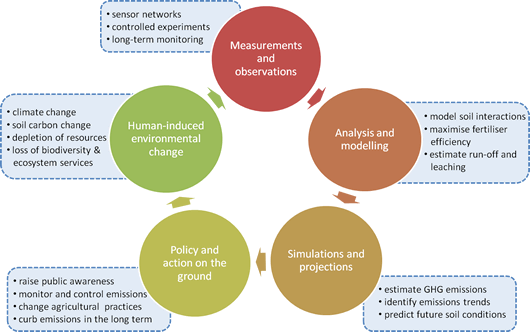Information For Policy Makers
Why focus on N2O from agriculture?
N2O is a powerful GHG. It is 296 times more potent than carbon dioxide (CO2) and stays in the atmosphere for up to 114 years. As the residual amounts of chlorofluorocarbons (CFCs) and other ozone-depleting gases disappear in the stratosphere, N2O is increasingly becoming the main contributor to thinning stratospheric ozone. This ozone helps protects Earth from harmful UV radiation. In the lower atmosphere, N2O is a precursor to tropospheric ozone which is both a pollutant and yet another GHG.
So, even though far less N2O is emitted than CO2, its potency and longevity makes it an important agent in climate change. Yet, to date, research and policy has primarily focussed on CO2 emissions, with attention to N2O emissions lagging behind. Soil scientists and farm advisors are calling for short-term management plans to control N2O emissions and long-term policies to reduce emissions.
The Garnaut Climate Change Review recommends committing resources to overcome gaps in nitrous oxide (N2O) emissions data so that they will be available to greenhouse gases (GHG) accounting and potentially for use in an emissions trading scheme. In Australia, the agricultural sector contributes 16.3% of Australia‘s total GHG emissions. This percentage is significantly high compared to many other developed nations; for example, agriculture both in the US and UK only contributes about 7% of total GHG emissions. This suggests that, in Australia,agriculture has a greater role to play in reducing GHG emissions.
Mitigating N2O represents a real and significant opportunity to reduce the greenhouse effect from anthropogenic emissions from agriculture. In 2007, Australian N2O emissions from agricultural soils were estimated at 20.2 million tonnes of “carbon dioxide equivalent” or 85.9% of all anthropogenic N2O emissions. Between 1990 and 2007, N2O emissions in Australia rose by 24%1 and this increase is largely attributable to the increased application of nitrogenous fertilisers.
An evidence-based, long-term policy on GHG emissions will address the long-term sustainability of agriculture in Australia, while improving land management practices. This can significantly reduce on-farm N2O emissions in the short term and lead to positive flow-on effects such as improving farming productivity and profitability.
Better access to research data and analysis of N2O emissions from Australian soils is a necessary first step for a comprehensive evidence-based national policy on gas emissions. Likewise, this access to research data will help the Australian farming community devise better land-use management.
The diagram below outlines the basic processes by which the Network‘s initial field measurements and observations are transformed into meaningful simulations and projections for policy makers implementing action for environmental change.

How N2O emissions science informs policy and action
Contributing to evidence-based policy
The N2O Network is the first national effort to bring together N2O emissions research data for agricultural soils from around Australia. Funding the N2O Network reflects the commitment of the Grains Research Development Corporation to investigate the effects of climate change-causing (GHGs) on Australia and how they can be best managed.
The network encompasses a number of research programs that collect N2O soil emissions data and analyse how local conditions contribute to the increase in emissions from farming practices. The N2O Network brings these programs together to create a comprehensive picture of N2O emissions across Australia. For the first time, emissions data from a range of climatic conditions, farming methods and crops are made available and accessible to researchers from a single source.
Meaningful Impact
New research resulting from data collected by the N2O Network will provide advice, trends and projections on N2O emissions that will:
- enable better policymaking for decreasing on-farm GHG emissions by quantifying agricultural gas emissions and how to manage them
- contribute to the National Carbon Accounting System – Department of Climate Change and Energy Efficiency – by estimating GHG emissions from managed land systems
- contribute to Australia‘s National Greenhouse Gas Inventory2
- reinforce the role of farmers as front-line participants in action to mitigate GHG emissions and climate change.
Footnotes
1,2 based on NGGI data from Office of Climate Change ageis.climatechange.gov.au; 1 accessed 17.5.2010, 2 accessed 4.6.2010
